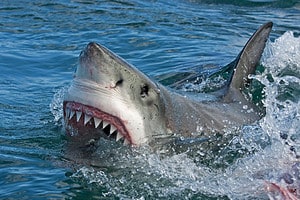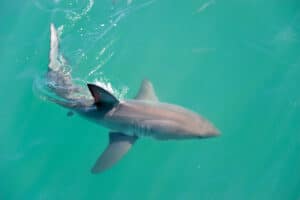The sevengill shark, or Notorynchus cepedianus, also goes by the name “cow shark.” Someone somewhere thought that this magnificent marine creature resembled a cow.
Anyways, before reading on, take a minute to Google the image of this shark species to see if you agree.
The argument for the similarity between our milk and meat-producing domestic animals is this. The blunt snout (which influences the name “broadnose sevengill shark”), stocky build, and gentle demeanor bring to mind the domestic bovine.
And there is more. Sevengill sharks are relatively slow swimmers. Although that should not deceive you into thinking you can outswim them. And beyond that is the ‘grazing’ behavior while feeding. They would instead source their food on the ocean floor, much like the cow prefers to feed on grass rather than reach for leaves.
Several anglers have had the pleasure of catching one of these magnificent creatures. Before we tell you who caught the largest sevengill shark ever in California, let’s get to know this shark a little better, shall we?
Where Does the Sevengill Name Come From?
The sevengill shark, also known as the broadnose seven-gill shark or cow shark, is named based on its distinctive physical characteristic of having seven gill slits instead of the usual five in most other species of sharks. The additional two gills are situated behind the fifth pair and provide this species with a greater surface area for oxygen uptake from seawater. This feature allows them to survive in deeper waters where there is less dissolved oxygen than in shallow coastal regions.
Interestingly, not all sevengill sharks have exactly seven gills! Some individuals may have six or eight depending on genetic variations within populations. Despite this variation, they are still classified under the family Hexanchidae, which translates to “six-rows” due to their unique arrangement of dorsal fins.
This prehistoric-looking shark can grow up to 10 feet long and has a massive head with sharp teeth that enable it to prey on fish, squid, rays, and even smaller sharks. They are found in temperate seas around the world but often inhabit colder waters such as those off southern Australia, where they gather in large groups during winter months for breeding purposes.
In addition to its unusual appearance and behavior patterns, The sevengill shark has been studied extensively by marine biologists due to its unique evolutionary adaptations and role as an apex predator in certain ecosystems. As more research continues into this fascinating creature, we may uncover further insights about how it evolved over millions of years into one of nature’s most successful predators.
Sevengill Breathing System
Unlike most sharks, sevengill sharks breathe by pumping water over the gills and can also take oxygen from the air. For more information on this, head over here to understand how fish breathe.
Most fish species, including sharks, use ram ventilation for breathing, which is when water passes over the gills while the fish is in motion to extract oxygen. Fish typically swim with their mouths open to allow water in. When water passes over the gills, the muscles have zero active pumping to get the life-giving air. The challenge is that water movement is necessary, so the fish has to be in constant motion.
The sevengill shark uses buccal pumping to breathe. It’s a variation of ram ventilation in that the mouth opens and closes. That way, the shark can remain stationary while still breathing. In this state, the shark will extract oxygen from water, thus another unique feature.
Sevengill Shark Height and Weight
The sevengill shark may not be near the top compared to its larger relatives. Indeed, most basketball players may even be taller, as the typical length ranges from 6 to 10 feet. A few grow to 11 feet, but that’s not the norm. Compare this to the whale shark, which can grow to 40 feet.
The sevengill shark also doesn’t weigh much; adults typically reach between 100 to 300 points. But a few, like the largest one ever caught in California, tipped the scale at an impressive 342 pounds.
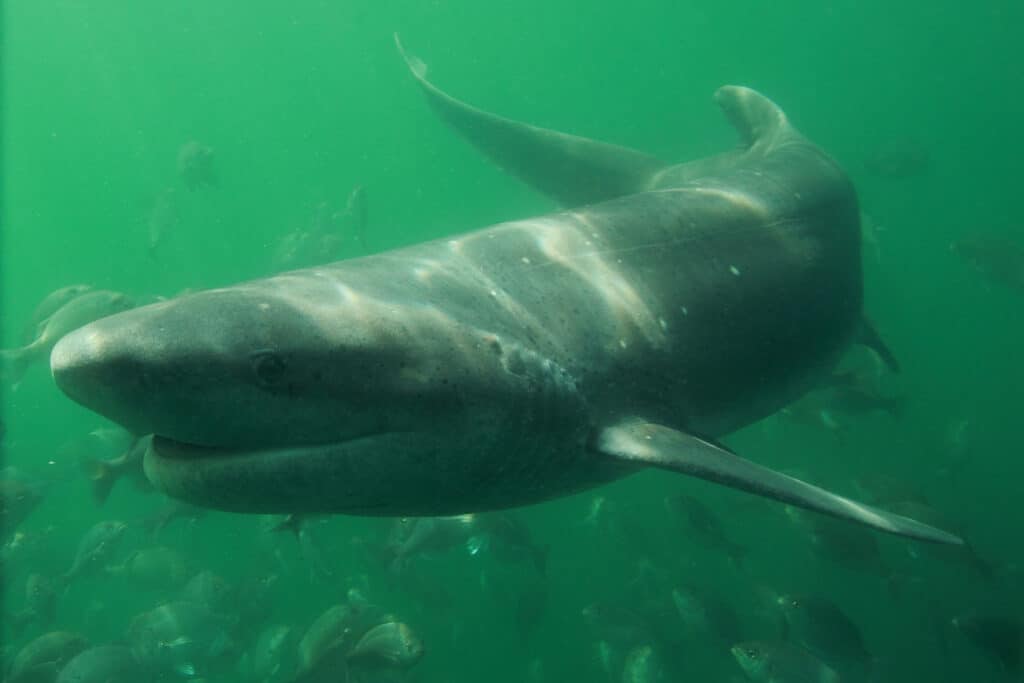
A sevengill shark (
Notorynchus cepedianus) can be found in temperate waters around the world, and is known for having seven gill slits, instead of the five found in most other shark species.
©iStock.com/AlAlessandro De Maddalena
Sevengill Shark Appearance
The most distinctive feature is the seven-gill slits unique to the shark. Like other sharks, it also has a broad, rounded head and pointy, razor-sharp teeth and small eyes.
Here’s a remarkable fact about the sevengill shark’s teeth: The lower jaw has a comb-shaped teeth arrangement, while the upper teeth are jagged. When hunting prey, the lower teeth become the jaw anchor. Next comes the characteristic shark head thrashing that allows the upper teeth to saw off flesh pieces. The two jaws achieve cutting-while-holding action, making the sevengill shark’s bite extremely powerful.
You’d think that’s all there is to know about the sevengill’s teeth, but there’s more:-
- The teeth get replaced continuously throughout the shark’s life. If only we, as humans, were that lucky.
- The lower jaw is wider than the upper one, allowing it to take massive prey bites.
- The habitat and diet determine the teeth’ shape. You’ll notice thinner and pointier teeth amongst sevengill sharks that predominantly eat fish. Those that feed on crustaceans or other prey with hard shells have thicker yet blunter teeth.
The sevengill shark’s color is brownish gray or what others may describe as counter-shaded. The fins and body have small black and white spots.
If you’re looking into the water from above, you may not even spot the shark as the color allows it to blend in with the deeper waters.
It gets more interesting, though. If you ever spot it from below the water during the day, you might have more difficulty seeing the shark in the dark. The underbelly features a lighter shade that perfectly melds with the surface water.
The color blending is an excellent camouflage; before you know it, a shark can sneak up on you and attack.
Sevengill Shark Habitat
The sevengill shark is coastal, preferring subtropical and temperate waters. But there are variations in habitats throughout the world. You’ll likely see them in California, Australia, South Africa, New Zealand, Japan, and Chile. However, you’ll not find this shark species in the Mediterranean and North Atlantic oceans.
Typically the sharks live in less than 50 meter-deep waters. Thus, estuaries and bays are their typical habitat. But a few may venture into continental shelves as deep as 570 meters. Due to their grazing nature, sevengill sharks love muddy, sandy, or rocky substrates.
Please note the location of the sharks also depends on the seasons. Long-distance migrations happen during winter, from coastal to continental waters and back in spring.
The sevengill shark’s adaptability to habitat variations is also worth noting. The sharks can tolerate different water temperatures, depths, and salinity. That could explain why they continue to thrive over 150 million years later, making them one of the oldest surviving shark species.
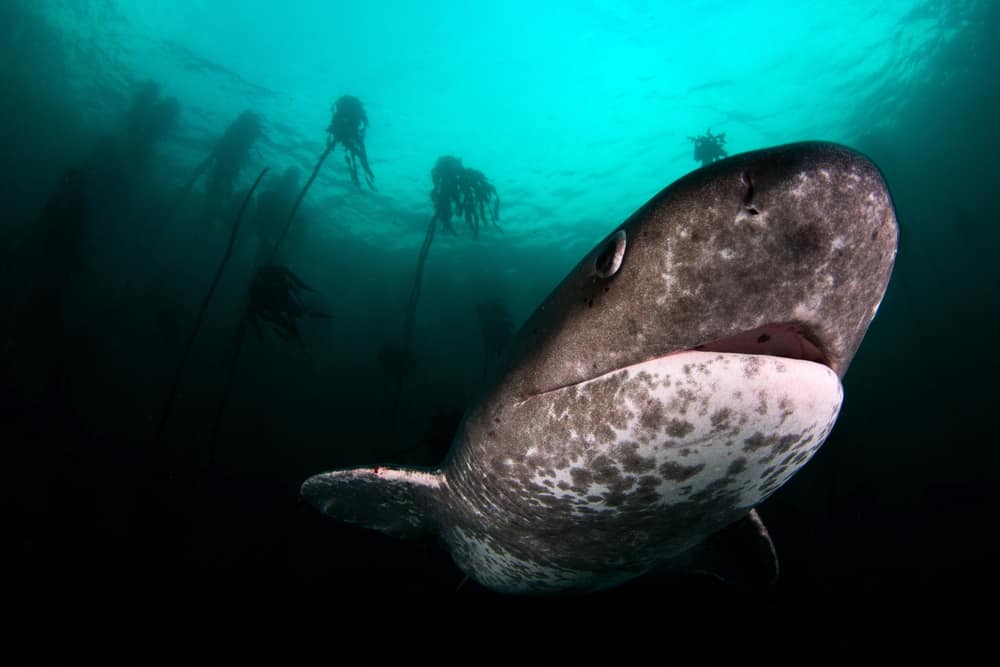
A sevengill shark can reach a maximum length of 3 meters and feed mainly on fish, octopuses, and crustaceans.
©Tomas Kotouc/Shutterstock.com
Sevengill Sharks Feeding and Hunting Habits
Sevengill sharks are predators that consume a variety of prey, such as fish, crustaceans, squid, and other sharks. Their opportunistic feeding pattern means they’re not picky but consume what’s available. And that includes dead marine carcasses.
The sharks are also avid hunters that prefer the night to hunt. Research shows that nocturnal hunting is a tactic the sevengill sharks use to catch unsuspecting prey. What also makes them quite effective as hunters is that they hunt in schools, which makes them quite deadly to even much larger prey.
Other methods that ensure a good supply of food include:
- Burst speed attacks
- Ambush low-light condition attacks
- Stealth hunting takes prey by surprise
- Foraging behavior and preference for shallow water depths ensures they don’t compete with larger predators for food.
Now here’s something interesting about the sevengill shark feeding habits. Food digestion can take days, depending on what they consume. That allows them to stay for weeks without needing to eat again. In terms of food capacity, they surprisingly don’t eat much. They can survive on about 6% of their body weight in food per month.
Sevengill Shark Breeding Patterns
Sexual maturity in male sevengill sharks occurs when they reach about 4.9 feet. For females, it happens at about 7.2 feet until around 9.8 feet.
Mating happens all year round, but mostly in spring when the sharks migrate back after the winter move. Males transfer sperm to females using their claspers.
Sevengills sharks are ovoviviparous (not to be confused with viviparous). In both cases, egg nurturing and embryo maturation occurs within the female body, resulting in live births. The difference is that in ovoviviparity, the eggs remain in the oviduct until maturity. These animals also don’t have a placenta or umbilical cord, which are critical nutrition pathways to developing embryos. Instead, the egg yolk is the developing embryo’s primary food and oxygen source.
Sevengill shark gestation can take anywhere from 12-15 months, after which the females move to shallow bays to give birth.
There are varying reports on how many litters a female can give birth to. It could range anywhere from 20 to over 80 pups. Each offspring measures about 1.3 to 1.7 feet long and comes out of the womb ready to fend for itself. Unlike humans and other mammals or birds, sevengill sharks have no parental instincts. Thus, they’ll not provide protection or care for the young’uns. And that includes the first meal out of the safety of the mother’s body.
Hunting and fishing come as instincts. The young pups have the instinct to survive larger predators. They’ll stick to protected areas like estuaries, bays, and shallow waters that larger predators typically stay away from for some time.
Various reports show that the sevengill shark population is dwindling so much that the International Union for Conservation of Nature classifies them as Vulnerable.
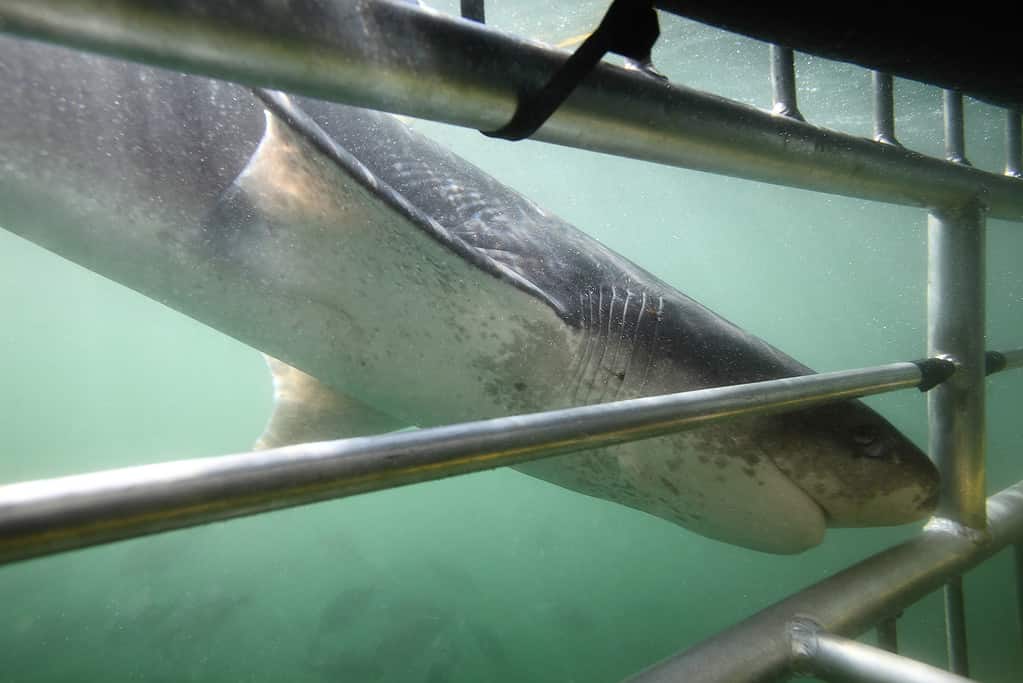
The sevengill shark can grow up to 8 feet long and weigh over 200 pounds! It’s an apex predator that primarily feeds on smaller fish, crustaceans, and even mammals.
©Alessandro De Maddalena/Shutterstock.com
Socializing Nature of Sevengill Sharks
Like other shark species, sevengill sharks display a social nature. They prefer to hang around in schools. They will also aggregate in deep water canyons and kelp forests. These fascinating creatures are also capable of somewhat human-like, very complex behaviors. For instance, they can recognize and interact with others from their species. They also display fun, playful behaviors like biting each other’s tails and rubbing against each other.
Unfortunately, the reasons for their social behavior remain at speculative levels. Some posit that the social nature may be a strategic move on the sevengill sharks’ part to ensure successful reproduction. Remember, their gestation period is quite long, so despite the large litter, the number of pups they reproduce over time is fewer.
Others argue that their social nature could result from the foraging patterns of food sourcing. Group hunting brings strength that comes from numbers. Locating and capturing prey is easier via group effort rather than individual effort.
Are Sevengill Sharks Dangerous?
Always have it at the top of your mind that all sharks are predators and thus dangerous. In the introduction, we discussed the docile nature of sevengill sharks, hence the comparison to cows. But take that bit of fascinating knowledge with a big pinch of salt.
Any wild animal will and can react negatively to what it perceives as aggressive behavior. There are no recent active reports of open water attacks. Although in captivity, they have attacked carers and divers.
Our best advice is to stay away and exercise utmost caution anywhere the sharks may be.
Hunting Regulations Governing Sevengill Shark Hunting In California
Sevengill shark fishing has been a popular pastime since the 1930s. The shark is valuable because of the liver oil. With the decline of fishing, commercial sport fishing took over, resulting in the depletion of the population. Please note that there are no actual records of the correct population size. Despite this, the sharks are, to date, hunted for oil, leather, and flesh for human consumption.
Anyone who has eaten sevengill shark would describe the taste as mild to slightly sweet. The flesh, whether steak or filet, is off-white after cooking. In terms of texture, it compares to tuna or swordfish. Some favorite cooking methods include frying, baking, or grilling.
Some sevengill sharks may be unsafe to eat due to high mercury levels and other contaminants. If you want to eat the meat, find out if the fish is from a well-managed population and caught from sustainable areas. Taking the necessary precautions if you react to seafood is also essential.
Hunting sevengill sharks must follow strict regulations by the California Department of Fish and Wildlife (CDFW). Due to the dwindling populations, the rules are necessary to ensure the sustainability of the shark populations.
California’s widest concentration of sevengill fish is in San Francisco Bay and Humboldt. They’re safe havens and nursery areas for juvenile sharks in these locations. Ongoing conservation efforts will be critical to ensure the continued existence of this unique shark species.
You must have a valid commercial fishing permit to try your luck at catching the largest sevengill shark. There’s a one-fish per-day restriction but none on the shark’s size. However, smaller sharks than 78 inches must return to the water.
If fishing for recreational purposes, it is mandatory to release the sharks back into the water alive. The law also prohibits the possession of body parts like teeth and fins.
Finally, you must report any catch to the CDFW for purposes of population tracking. Anglers can access the department’s online portal for this. You must submit information such as species, location, and fish size. Please do proper research to familiarize yourself with specific area regulations.
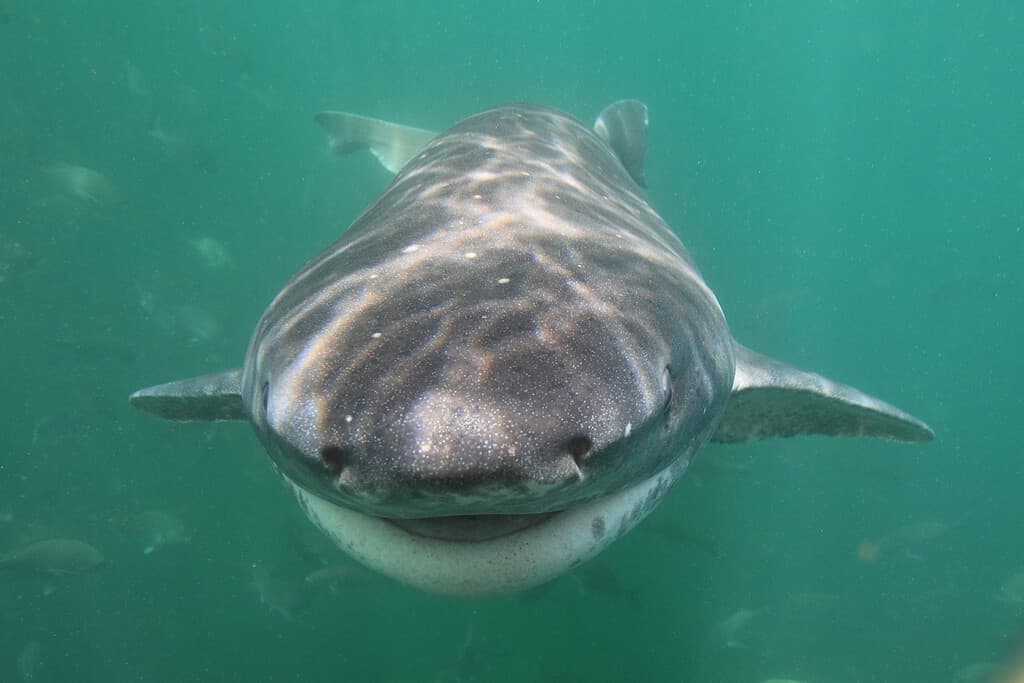
A sevengill shark swimming off the coast of South Africa. These large, predatory fish can grow up to three meters in length and play an important role in maintaining balance in their marine ecosystem.
©Alessandro De Maddalena/Shutterstock.com
Largest Sevengill Shark Ever Caught In California
Details are sketchy on the largest fish ever caught in California. But the record could go to Chris King and John McGhee. The title of largest sevengill shark ever caught in California goes to Chris King and John McGhee for catching a 342-pound sevengill shark in San Francisco Bay on July 2nd, 2017. John came along as the proprietor of the Sportfishing outfit Chris was using.
The new 342 catch ousted the 2013 record by Johnny Mathews of Stockton. He caught a 322-pound cow in the same area.
Where is San Francisco Bay Located on a Map?
San Francisco Bay is a large body of water located on the west coast of the United States in Northern California. It is surrounded by several cities, including San Francisco, Oakland, and Berkeley. The bay itself stretches over 400 square miles and has many different access points for visitors to explore.
If you are looking to go fishing for sevengill sharks, one popular spot is near Alcatraz Island. The waters around this famous prison offer ample opportunity to catch these impressive predators. However, it is important to note that fishing regulations in the area require catch-and-release only for sevengill sharks.
To get to San Francisco Bay, there are several options depending on your location and mode of transportation. For those traveling by car, there are multiple highways that lead directly into San Francisco, such as Highway 101 or Interstate 80. If you prefer public transportation, there are also trains and buses available throughout the region.
Once you arrive at one of the many access points along the bay, be sure to take advantage of all that this beautiful location has to offer. From stunning views of the Golden Gate Bridge to hiking trails through nearby parks like Muir Woods National Monument, there is something for everyone here in San Francisco Bay.
The Fascinating Sevengill Shark is a Wonder of Nature
The Sevengill shark is a fascinating, unique species. The extra gills and ability to take in oxygen using two methods are impressive. They can stay for days without eating, and the socialization aspects make it all the more exciting.
Also, there’s the fact that it is an excellent animal to target recreational fishing. Please ensure you have the necessary permits before setting out to beat the record of the largest sevengill shark ever caught in California.
The photo featured at the top of this post is © iStock.com/Alessandro De Maddalena
Thank you for reading! Have some feedback for us? Contact the AZ Animals editorial team.



